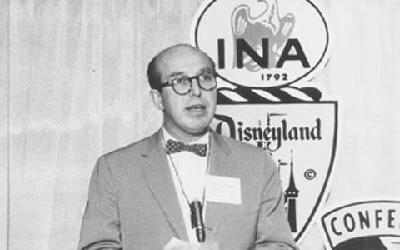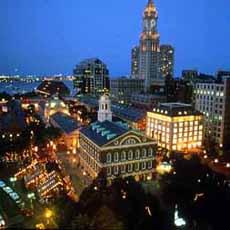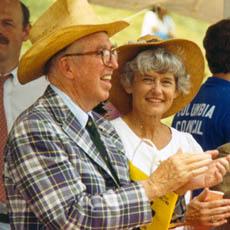
STEVE EMBER: I'm Steve Ember.
FAITH LAPIDUS: And I'm Faith Lapidus with PEOPLE IN AMERICA in VOA Special English. Today we tell about James Rouse. He was a developer who found new ways to improve American cities.
(MUSIC)
STEVE EMBER: It was a gray day in 1973. James Wilson Rouse got off a train in Boston, Massachusetts. He had come to see a very old building that was almost empty.
Mr. Rouse owned a company that developed property. Another official of the company was on that trip. The official remembered that the building looked terrible. Part of it was burned out. It was filled with holes where rats lived.
Yet, the official said: "Jim was very happy. He said it was going to be great. The man could see things no one else could see."
FAITH LAPIDUS: The damaged building James Rouse was inspecting became the beginning of Boston's famous Faneuil Hall. Repaired and rebuilt, it is an important part of a historic cultural center for stores, ethnic foods and street performers.

The center is designed to show life as it was in the 1700s. Millions of people from all over the world have visited Faneuil Hall.
Faneuil Hall is just one of many "festival marketplaces" that James Rouse created in the centers of older cities. Festival marketplaces are large centers for shopping, eating and other pleasant activities. He built other major centers in New York City; Baltimore, Maryland and Miami, Florida.
STEVE EMBER: Harborplace in Baltimore is a good example of James Rouse's festival marketplaces. In the 1700s, the land on which the Harborplace development was built served as a trade center for Baltimore. Many ships sailed to and from this area of the eastern American port city.
Over the years, however, this busy, successful waterfront area changed. By the middle of the 20th century, businesses were failing. Many buildings were empty and in need of major repair.
The Baltimore city government decided to establish a plan to re-build the area. The plan called for a waterfront development that would combine business and pleasure.
FAITH LAPIDUS: James Rouse's company won the right to develop part of the area. The project was to be called Harborplace. The first part of Harborplace opened in 1980. Later in the 1980s, the Rouse Company developed another area called The Gallery at Harborplace.

Today, millions of people each year visit Harborplace and The Gallery in Baltimore, Maryland. They shop and eat in many stores and restaurants. They watch music, dancing and plays performed near the water. And they enjoy the mix of people and activities that brings new life to the center of that old city.
(MUSIC)
STEVE EMBER: James Rouse was born in 1914. His family lived in a farming area on the eastern shore of Maryland. His father and mother died within a few months of each other in 1930. They left their five children without much money.
The parents owed a bank a lot of money for their house. So the bank was forced to take away the family home. James was able to find a job to pay for his college education. He later graduated from the University of Maryland Law School in 1936. He began working for a bank in Baltimore.
FAITH LAPIDUS: In 1939, James Rouse and a banker, Hunter Moss, borrowed 25,000 dollars. They formed a company that lent money to people who wanted to buy homes. During World War Two, Mr. Rouse served as an officer in the Navy in the Pacific area.
After the war, he returned to Baltimore. His business grew. It represented banks and provided loans to people returning from the war who wanted to buy homes.
James Rouse became a rich man. During the early 1950s, he also became known for social action as well as property development. He tried to improve a poor, undeveloped area in east Baltimore. The mayor of the city said he would not offer complete support for a plan to rebuild the poor area. So Mr. Rouse resigned from a citizens' committee that was supporting the plan.
STEVE EMBER: Also in the 1950s, Mr. Rouse began a project that brought him national fame. He began building some of the first enclosed shopping centers in America. He built a lot of these shopping malls in Maryland and other states. Each mall had stores and businesses inside a large building. They were built outside cities, in the growing housing areas called suburbs.
James Rouse wanted to develop land for the good of society and the environment, not just for profit. In the 1960s, he dreamed of building a complete new city between Washington, DC and Baltimore, Maryland.
His company bought ten percent of the property in Howard County, Maryland. The company bought more than 57 square kilometers of land from 140 separate owners.
FAITH LAPIDUS: In 1963, James Rouse announced that his company would help build a new planned community. By creating separate villages within the community, it was to seem like a small town. Each village would have a shopping center, open spaces and homes. The new community of Columbia, Maryland began in 1967.
Today, more than 94,000 people live in the city.
(MUSIC)
STEVE EMBER: In 1972, three members of a Washington, DC church came to visit James Rouse. The three belonged to the Church of the Saviour, where James and Patricia Rouse had been married.
The women asked Mr. Rouse for advice about creating housing for poor people in the Adams Morgan area of Washington. But Mr. Rouse thought people who knew nothing about development, money or building could not possibly create low-income housing.
FAITH LAPIDUS: The women did not give up their goal. Instead, they invested money to buy two apartment house buildings in Adams Morgan. The buildings were in terrible condition. Mr. Rouse helped them get 625,000 dollars to complete the deal. He also helped them get 125,000 dollars to repair the buildings.
Their project was huge. People worked for no pay for 5,000 hours to repair the buildings. Workers cleaned out garbage and rats. People also gave additional financial help for the restoration. More than 900 housing violations were corrected. The completed project provided 90 apartment homes for poor people. They were called Jubilee Housing.
STEVE EMBER: James and Patricia Rouse served as advisors for Jubilee Housing. Mr. Rouse retired as head of his development company. Then, in 1982, they took a further step toward helping poor and middle-income people. They established a new organization, the Enterprise Foundation. They used profits from Mr. Rouse's company to start the foundation. Its goal is to give poor people in America a chance to live in clean, pleasant places.
Since then, the Enterprise Foundation has worked with thousands of community groups and other organizations. Each year it provides thousands of new or re-built homes for poor and middle-income families.
(MUSIC)
FAITH LAPIDUS:
Many experts say that James Rouse helped shape the look of the United States for years to come. In 1995, President Clinton gave him the Presidential Medal of Freedom. It is the highest award a civilian can receive. He was honored for his work restoring the central areas of cities. President Clinton said that James Rouse's life was based on a strong belief in the American spirit.
James Rouse died in 1996. But the work of the Enterprise Foundation continues with help from family members. One of these is the Rouses' grandson, Edward Norton, a movie actor. He developed a project to help poor people heat their homes. It is a joint project with the organization his grandparents established.
The influence of James Rouse continues today in other ways. Developers continue to re-build and improve poor areas of cities. And millions of people visit historic centers like Faneuil Hall and Harborplace every year.
(MUSIC)
STEVE EMBER: This program was written by Jerilyn Watson. Lawan Davis was our producer. I'm Steve Ember.
FAITH LAPIDUS: And I'm Faith Lapidus. Join us again next week for PEOPLE IN AMERICA in VOA Special English.
Dian Fossey, 1932-1985: she worked to protect the mountain gorillas of central Africa
Patsy Cline, 1932-1963: fans were 'crazy' about this young country music star
Flannery O'Connor, 1925-1964: she told stories about people living in the American South
People in America - Bob Feller, 1918-2010: One of baseball's finest pitchers
(來源:VOA 編輯:崔旭燕)
